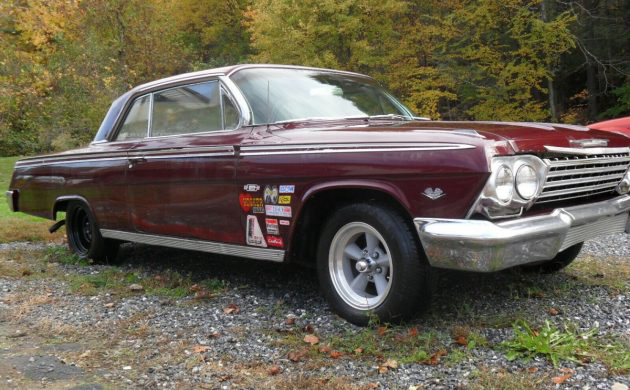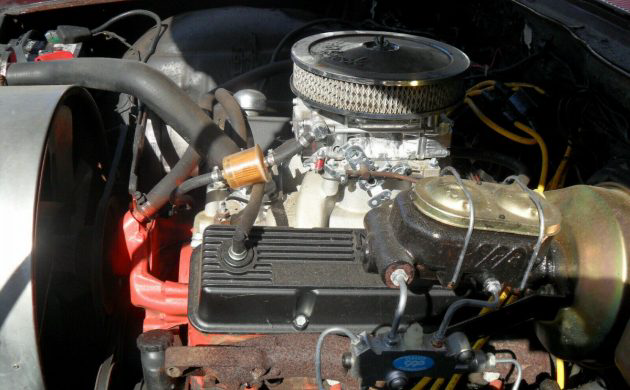Most classic car enthusiasts will hold a soft spot for any vehicle that has been in long-term ownership. That is the case with this 1962 Chevrolet Impala. It has been part of the same family for nearly 60 years, and its current owner took possession of it in 1980. He undertook some bodywork and rust repairs at that point and then parked the car for nearly forty years. He has recently revived it and performed some mechanical upgrades, but with no enthusiasm for the project, he has decided it needs to go to a new home. Located in Beacon Falls, Connecticut, you will find the Impala listed for sale here on eBay. The owner has set a BIN of $14,000, and this classic has generated enough interest that forty-two people are currently watching the listing.
This Impala has worked its way through several members of the same family since it rolled off the production line in 1962. The current owner received the car in around 1980, and at that stage, it wore its original Ermine White paint. However, he wasn’t a fan of that shade, so he performed a color change to its current Honduras Maroon. Before applying this new paint, he completed a few essential rust repairs. These included a partial rear quarter panel replacement and new lower door skins. There was also some rust in the floors that required patches. The rust in the doors and quarter panels has begun to reappear, but it hasn’t progressed to a horrendous point at this stage. Once again, the buyer could choose to patch these areas or replace the door skins entirely. The quarter panels aren’t that bad, and while some potential buyers may find it hard to justify replacement, a perfectionist may follow that path. The patches in the floor are okay, but once again, a meticulous owner would probably look at replacing the pans. Beyond that, this Impala appears to be rock solid, with no apparent structural issues. Most of the external trim is in good order, as is the glass. It will require some massaging, but the Impala should look pretty stunning once complete.
Mechanically, this Impala is a mystery machine. Lifting the hood reveals a V8, but the owner is unsure whether it is a 283 or a 327. Bolted to the back of this motor is a two-speed Powerglide transmission, while the vehicle also features power steering and power brakes. After performing the panel and paintwork, the owner parked this classic in a barn in around 1980. He dragged it out of hiding last year and worked through reviving it. The process included replacing virtually the entire fuel system, including the tank, lines, pump, and carburetor. The car roared back to life and sounded fantastic, but the owner had little confidence in the four-wheel drum brakes. With an eye to safety, he upgraded the master cylinder and converted all four corners to discs. That should provide plenty of confidence when the next owner has to stop this car in a hurry. His lack of enthusiasm for this project is reflected by what happened after he had revived it. Once he reached the point where it ran and drove, he parked it straight back in the shed it had occupied for four decades. He has kicked it back into life about every three months to keep the fluids moving, but it hasn’t seen the road since. It seems that it would take little to return it to a roadworthy state, which offers the tantalizing prospect of driving the car immediately and performing restoration work as time and circumstances allow.
If I were to categorize the state of this Impala’s interior, I would describe it as serviceable but in need of some TLC. A few components are missing from the dash, while the upholstered surfaces now show their age. The supplied photos don’t provide a clear picture of the state of the upholstery, but some splits and physical damage to the seats are visible. The next owner could throw on a set of aftermarket slipcovers and drive the car as is, and that may be a wise move if the budget is a bit tight. A complete retrim would be the best approach if money is no object. Sourcing individual parts can be horrendously expensive, and even complete kits for a ’62 Impala are among some of the most expensive that you will find for a classic Chevrolet. These generally start at around $2,500, although they can push beyond the $3,000 mark. If the next owner is not in a hurry, shopping around may reduce those figures. It would certainly be worth the time and effort to minimize the cost of this restoration.
I believe that this 1962 Impala has generated interest for several reasons. The first is that these classics are considered pretty desirable in any form. Its cause has been helped by the V8 under the hood and the recent mechanical upgrades. Finally, the owner has been quite candid about its needs and the sorts of work the buyer will face returning this Chevy to its former glory. It represents a lot of steel for the money, and it will be interesting to see if somebody hits the button to give this Impala a new home.







The racing stickers are perhaps boastful, but I doubt that mill is particularly snappy.
In the late 60’s teenage boys like me and all my friends decorated their cars with racing equipment stickers. It was a thing. No regard for what the equipment was. And on the back window, a Dewey Weber Surfboards decal.
Fender flags suggest it’s a 327. 283’s just had a V on the fender if I recall.
Your recollection is correct. The 409 had the V, flags and the number 409. Sixes had a shield with a 6 on it.
Another impala low rider !
If it was me I would have removed the licence plate. Who wants to refer to their car with that two letter abbreviation.
the 1962 chevrolet is an icon. especially with a numbers matching 327 cu in engine,,I have had several of these cars in the past,,,I would suggest the new buyer check the rear part of the frame,,,they have a tendency to rot out,,my rule of thumb usually goes with these cars for me,, a basic 10k in the drivetrain, a basic 10k in the body,, add that on to the price,, is the car worth 34k,, I say yes,,,
If I had a car in my family for 60 years, I would be unable to sell it. Once you sell something you can never get it back.
Don’t know where the car was when the pictures were taken, but I’ve never seen such foliage anywhere around Mesa AZ. Just wondering
I highly doubt if it is the original engine, alternator is on the wrong side so there are bolt holes in the front of the heads, so those are 69 or newer. Along with the long style water pump and pcv valve in the valve cover. so I am thinking 350 or 307
Response to 8banger,I have had several “snappy” 283s.
There are a lot of things on that motor that tell me it’s a later model. I’m with Norman on that. All 62’s came with a generator mounted high on the driver’s side. You can see the two holes in the front of the exhaust manifold where it would have mounted, so it does have a 62 exhaust manifold. 63 was the first year for an alternator.
I had a white 62 from 1972 to 1978. I traded it to my Dad for a 57 Bel Air and by the time a few years later when I could afford both, Dad had sold it to a family friend. It tore me up for 20 years seeing Dad’s friend driving my car. The guy retired in 2001 and wanted cash to finish a street rod project, so I was able to buy my car back. Of course I paid five times what I got out of it, but I consider myself lucky to get another chance to own it.
I was really fortunate that Dad and his friend treated it as a collector car, the only thing I had to replace was the seat upholstery. It wasn’t bad, but the thread holding it together was coming apart so it got new seat covers. Now the sun visors are coming apart, so they will get new covers next spring.
I’ve had a few of theses early 60’s impalas, belairs, etc. As stated above rear frame could have issues….If you see cracks developing on top or rear fender, rear frame section has bit the dust